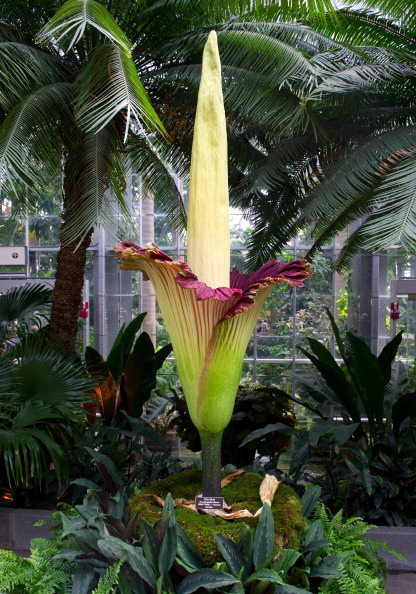
By happy coincidence and far from its native home in western Sumatra, titum arum, the world’s smelliest bloom, flowered at Paignton Zoo in Devon and at the Royal Botanic Gardens in Edinburgh. It’s a rare event, but not to be outdone—in New York, Cornell University’s titan arum has also been showing off.
While in a recent study researchers identified the enzyme that plays a key role in producing the sweet fragrance found in roses, titum arum – or Amorphophallus titanum to give it its Latin name – is famed for a very different type of smell: that of rotting flesh. As one witness in Edinburgh put it: “At its peak in the glasshouse it actually made our eyes water.”
So what is this amazing plant, and why is it so smelly?
We have the Victorians to thank
The Victorian age was great for exploring. It was deep in present-day Tanzania in November 1871 that the American journalist Henry Morton Stanley uttered his famous (alleged) words: “Dr Livingstone, I presume?” A few years later in the rain-forests of Sumatra in 1878, a slightly less momentous, but much more unpleasant discovery was made, when a botanist from Florence named Odoardo Beccari probably became the first Westerner to observe the smelliest plant in the world. He sent some seeds and tubers back home – from where some seeds made their way to Kew Gardens – and it was there that Amorphophallus titanum flowered for the first time in the West in 1889. It actually has a British relative, Arum maculatum, perhaps better known as cuckoo pint.
Cultivating Amorphophallus titanium isn’t a job for the impatient. It flowers irregularly, every few years. The plant has a vast underground tuber, which can weigh up to 75kg and produces a huge leaf, which can grow up to six metres tall. Sometimes it instead produces a huge inflorescence, stretching up to three metres high, with very small individual male and female flowers at the base, surrounded by a kind of giant green petal called a spathe. On average this only happens around every 10 years. But when it does, you certainly know about it, and they say that you can smell it from half a mile away.
A master of disguise
Its rotting flesh smell gives titum arum other alternative names such as the corpse flower or carrion plant. Its smell is designed to attract insects such as flies and carrion beetles, which normally feed on decaying flesh, which will help pollinate it. The spathe is green on the outside but the flower head is red, so it looks like meat. This plant is really cunning – as it blooms it gives out quite a lot of heat, up to 36°C, which encourages the molecules to spread out by helping them vapourise, and also confirms the impression of “warm meat”. The insects crawl over the spathe to leave their eggs in what they believe to be rotten meat, in the process transferring pollen – and this pollinates the plant.
Some years ago, scientists at Kew Gardens identified the molecules responsible for these awful smells. The main ones are called dimethyl disulphide (DMDS) and dimethyl trisulphide (DMTS); they’ve been known in the laboratory for years, and yes, they do smell disgusting.
In small amounts
In small amounts, molecules such DMDS and DMTS are an “off-flavour” in beer (DMDS is a byproduct of the fermentation process). The scientists looked at various species of the genus Amorphophallus (Araceae, the Arum family), including the titan arum, and found that most made DMDS and DMTS. Some also use other molecules, organic acids like the ones found on “sweaty skin”, as well as indole, a molecule partly responsible for the smell of human faeces. It’s not the only type of plant to smell like this. Scientists who examined the South African stinkhorn fungus (Clathrus archeri) discovered that it was producing dimethyl disulphide, just like a sample of rotten meat (and a dead rat).
Another arum (Helicodiceros muscivorus) is known as known as “dead-horse arum” (you can guess why). It is found in Sardinia and Corsica. It uses dimethyl sulfide (DMS) as well as DMDS and DMTS to attract blowflies. Dimethyl sulphide is a molecule we’ve all smelt, it is part of the sulphur cycle and is responsible for the “smell of the seaside”. Dimethyl sulphide is also the molecule that pigs and dogs look for when they detect black truffles underground in some parts of France. DMDS and DMTS are associated with the smell of Italian white truffles.
So Amorphophallus titanum isn’t what most people have in mind when they “say it with flowers”. These use a cornucopia of molecules with amazing smells to lighten our day and reach the emotions that words cannot.
This article originally appeared on The Conversation
More Must-Reads from TIME
- Donald Trump Is TIME's 2024 Person of the Year
- TIME’s Top 10 Photos of 2024
- Why Gen Z Is Drinking Less
- The Best Movies About Cooking
- Why Is Anxiety Worse at Night?
- A Head-to-Toe Guide to Treating Dry Skin
- Why Street Cats Are Taking Over Urban Neighborhoods
- Column: Jimmy Carter’s Global Legacy Was Moral Clarity
Contact us at letters@time.com